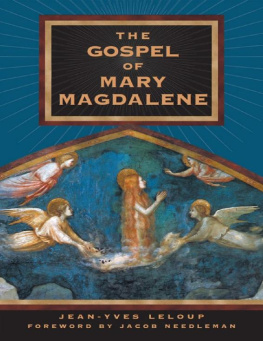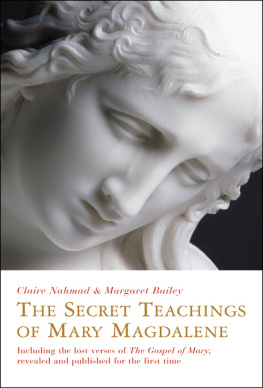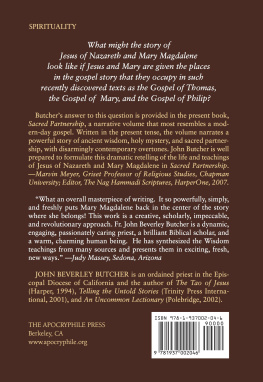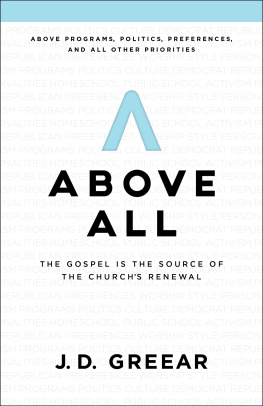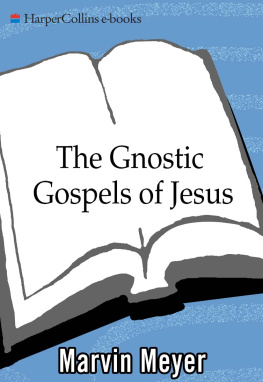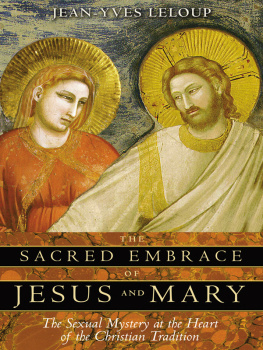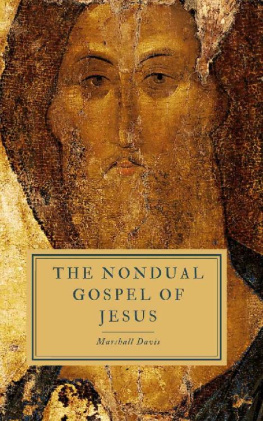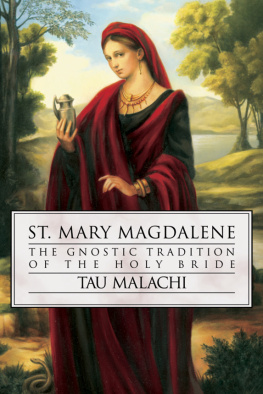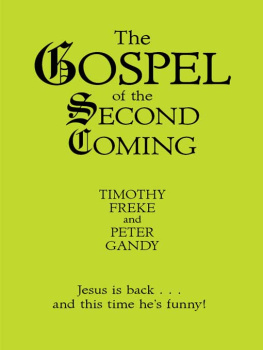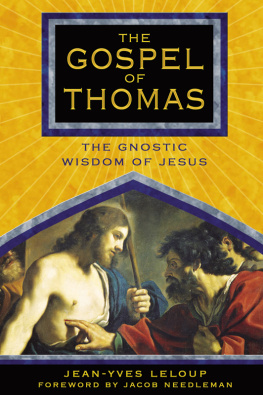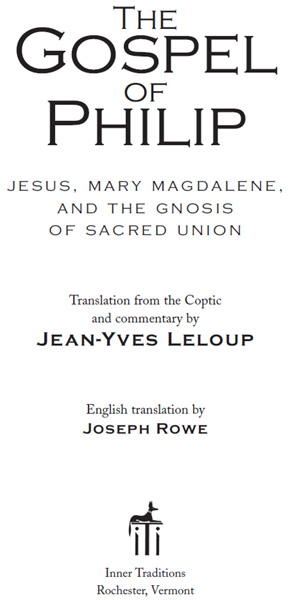

LIST OF ABBREVIATIONS
| 1 Cor | First Epistle of Paul to the Corinthians |
| Acts | Acts of the Apostles |
| Jer | Book of Jeremiah |
| John | Gospel of John |
| Luke | Gospel of Luke |
| Mark | Gospel of Mark |
| Matthew | Gospel of Matthew |
| Philip | Gospel of Philip |
| Thomas | Gospel of Thomas |

FOREWORD
The discovery in 1945 of manuscripts that have come to be known as the Gnostic gospels was one of the most momentous archaeological finds of our time. Accidentally unearthed by an Egyptian peasant near the desert village of Nag Hammadi and dating from the very beginnings of the Christian era, these texts have exerted a profound influence on our thinking about the origins and nature of Christianity, an influence that continues to grow with every passing year.
Like many of these Gnostic documents, the text of the Gospel of Philip consists mainly of sayings and doctrines attributed to Jesushere called Yeshuawhich point to an astonishing body of knowledge about man and the cosmic world and about the practices leading to inner freedom and the power to love. As is common in all the great spiritual traditions of the world, this knowledge is expressed mainly in allegory, myth, and symbol, rather than in the intellectual language we have become accustomed to in science and philosophy.
How are we modern men and women to understand these ancient sayings and symbols? What are they telling us about the illusions that suffocate our minds and freeze our heartsand about the way of life that can actually awaken us to what we are meant to be? Do these texts ask us to deny essential doctrines of Christianity that throughout the ages have brought hope to millions? Many observers view them in that way. For others, the effect of these documents has been to provoke a hardened skepticism that dismisses them with such labels as superstition, or heresy. Yet another widespread reaction has been to treat this material as justification for either uncritical speculation about the life and mind of Jesus or blanket condemnation of those who sought to stabilize the institution of the Church in the turbulent centuries immediately following the death of Jesus.
The work of Jean-Yves Leloup presents a wholly different approach to these writings, one that is formed by a rare combination of spiritual questioning and masterful erudition. As has already been shown in his translation and study The Gospel of Mary Magdalene, these Gnostic codices must be offered to us in a way that helps us to hear themto hear what they actually may be saying in response to our eras newly awakened need. It is as though after two thousand years of Abrahamic religionJudaism, Christianity, Islamthe unending barbaric violence and moral desolation of humankind has finally brought the whole of our global world to a life-or-death hunger for a new kind of knowing and moral direction.
Can the ideas and practical indications contained in the Gospel of Philip and the other Nag Hammadi texts be approached as something more than fascinating curiosities far from the so-called mainstream of our cultures canons of knowledge and faith? Is the world itself, or enough people in the world who can make a difference, ready to hear with new ears the forgotten wisdom of humankind offered in a language free of the opinions and emotional associations that have decayed into illusory certainties and eviscerated moral sensibilities?
Perhaps such texts as the Gospel of Philip contain, necessarily in the form of symbolic language, a treasury of answers that we as individuals might have all but given up hope of finding. In a time when the role of religion in human life has become one of our worlds most agonizing concerns, texts such as the Gnostic gospels invite us to risk stepping back in a new way from many of our most cherished opinions not only about the teaching and acts of Jesus, but about who and what we are as human beings. As this book indicates, it is in this specific new effort of separating from our own thoughts and feelings that an entirely unexpected source of hope may be glimpsed, both for ourselves and for our world.
To begin to understand this text, we need to have a question, and to question ourselves. That said, the issue then becomes not only what are our questions, but how do we ask them? What does it really mean to have a serious question of the heart and to ask it from the whole of ourselves, or at least from the part of ourselves that is able to hear an answer? For one of the most remarkable aspects of spiritual knowledge (in the ancient meaning of the term gnosis) is that its answers can be fully received only in response to a real question, a real need. And it is no doubt trueand also often forgottenthat the inner meaning of all scripture, whether canonical or not, can be received only in the state of spiritual need. If approached without this need or genuine state of questioning, texts such as the Gospel of Philip are likely to be either regarded at arms length as mere scholarly and archaeological riddles or curiosities, or greedily appropriated as fuel for fantasy. The first step then toward a new kind of questioning, a new kind of knowing, is a step back into ourselves, apart from all that we think we know about ourselves. If there is such a thing as transformational knowing (and this is the true meaning of the term gnosis), its first stage is the inner act of not knowing.
In his beautiful and courageous introduction to the Gospel of Philip, Jean-Yves Leloup concludes by saying, I have articulated some of the questions raised by this gospel. I have never pretended to have the answers to these questions... Yet he goes on to add that this must not lead me to deny the nearness of a source that is capable of satisfying the thirst for these answers.
He does not dare to name that source. But as we turn the pages of the text itself, we may begin to sense numerous indications of its nature in the bittersweet state of self-questioning that this gospel can evoke. Under Jean-Yves Leloups hand, we are guided to both the known and the unknown in ourselves and in our understanding of the Christian teaching.
Concerning our relationship to the teachings of Christianity, Leloup invites us to regard this hitherto hidden and secret text as pointing to the hidden or subconscious teachings of Christianity, in the sense that what is ontologically subconscious in human life is what secretly influences and directs that which we call our consciousness. This is to be contrasted with the well-known or, in this limited sense of the word, conscious canonical Gospels under the light of which, in Leloups words, the Church originally staked a claim, so to speak, on the entire territory of Christianity, fencing in a land that was originally open and free.
We might also think of the subconscious and the conscious as essence and manifestationwhat we are in the depths of our hidden being and how we act and manifest in the conditioned and relative realm of time and the world we live in. It might also be suggested that in our own individual lives, as well as in the life of a great tradition that compassionately struggles to penetrate the worldly life of humankind, essence and manifestation often drift apart from each other, to the point that outer expression or manifestation loses or forgets its source and essenceand thereby, knowingly or unknowingly, even contradicts or denies the authority of its source. In that case, to confront essence and manifestation together, especially in their accrued mutual contradiction, is nothing less than a great shock of awakeningand it is there where we may experience the state of self-questioning that is both joyous and bittersweet.
Next page

